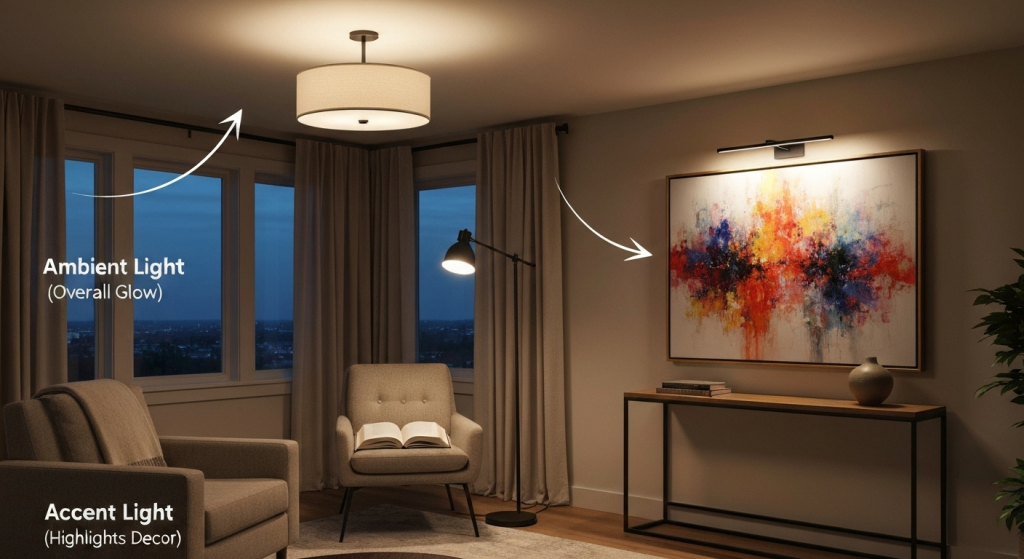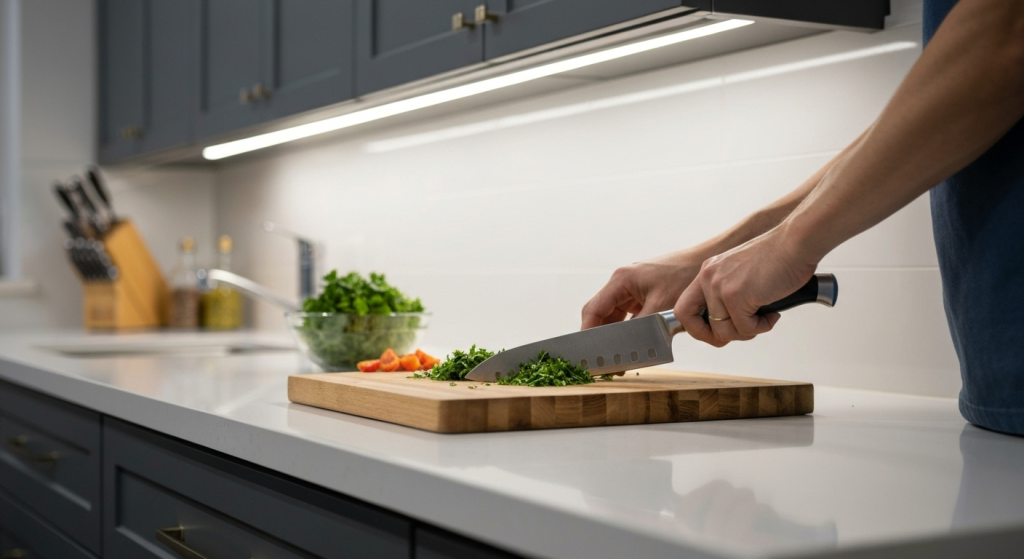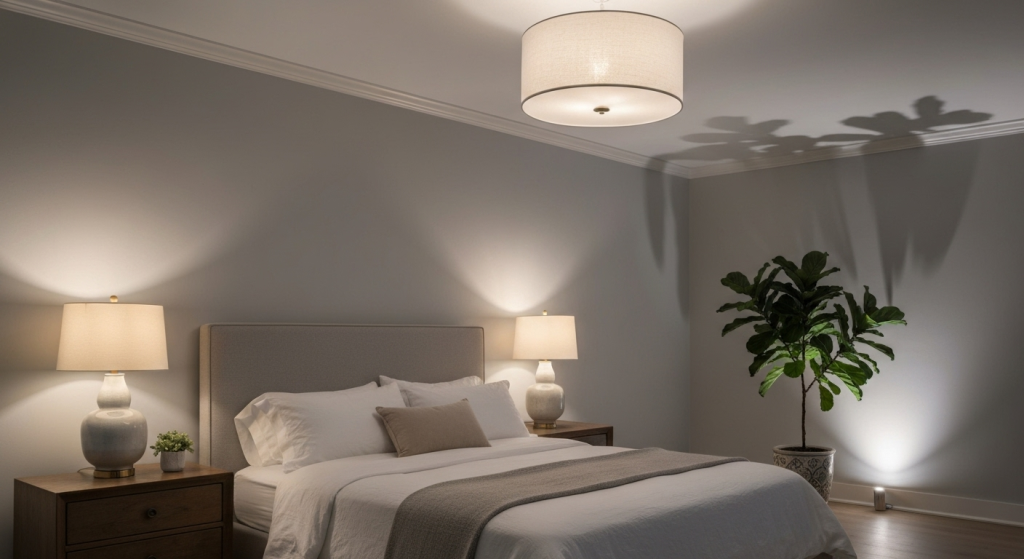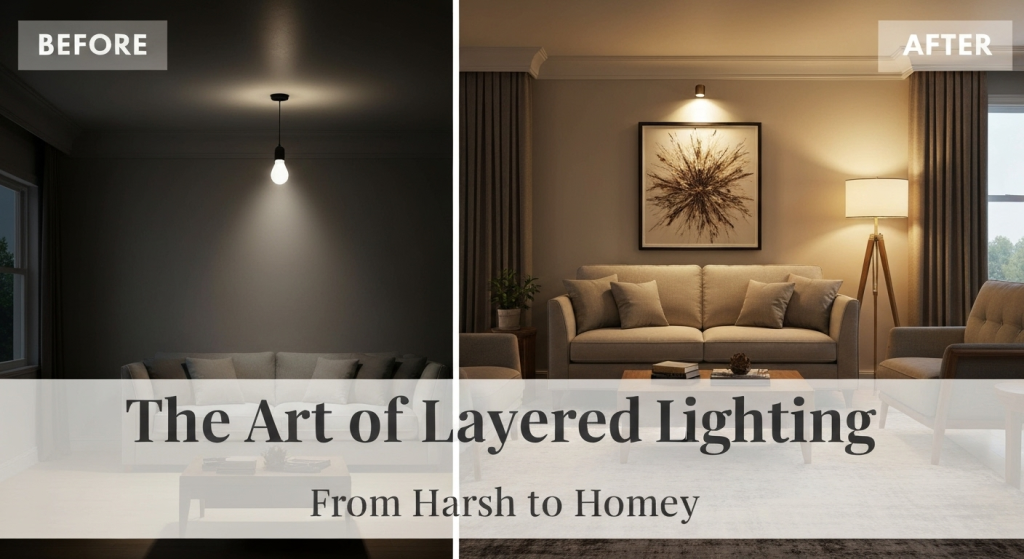Layered lighting is one of the most powerful tools in home design, yet it’s often overlooked. If your room feels more like a sterile office or a dim cave than a cozy sanctuary, the problem probably isn’t your furniture—it’s your lighting. Many of us live under the tyranny of a single, harsh overhead light that casts unflattering shadows and does nothing to create a welcoming atmosphere. The solution is simpler than you think: learning to layer your light.
My own fascination with lighting began when I moved into an apartment with terrible lighting. The living room had one ceiling fixture that either blinded you or left you in the dark. Frustrated, I started experimenting, adding a floor lamp here, a small table lamp there. The change was instant and dramatic. Over the last five years of working in and writing about home decor, I’ve seen this transformation happen time and time again. It’s not about expensive renovations; it’s about understanding how different types of light work together. My goal is to share what I’ve learned, helping you turn any room from functional to fantastic using the simple art of layering.
This guide will break down the three essential layers—ambient, task, and accent lighting. We’ll explore what each one does and how to combine them to create spaces that are not only beautiful but also perfectly functional for your everyday life.
What Exactly is Layered Lighting?

Let’s break it down. Layered lighting is a design technique that uses multiple light sources to create a balanced, flexible, and visually interesting space. Instead of relying on one light to do everything, you combine three different types of lighting, each with a specific job.
Think of it like painting a picture. You start with a base color (ambient), add the main subjects (task), and then finish with small details and highlights that draw the eye (accent). When these layers work together, they eliminate harsh shadows, reduce glare, and give you complete control over the mood and functionality of your room. It’s the difference between a flat, one-dimensional room and one that feels rich, warm, and alive.
The real beauty of this approach is its flexibility. With layered lighting, you can easily change the feel of a room with the flick of a few switches. Bright and energetic for a party? Done. Soft and relaxed for a quiet evening? Easy. This adaptability is what makes a house truly feel like a home.
The First Layer: Ambient Lighting (The Foundation)
Ambient light is the general, overall illumination in a room. It’s your primary light source, the foundation upon which all other layers are built. Its main job is to provide enough light for you to see and move around safely and comfortably. It sets the overall tone of the space. Natural daylight is the best form of ambient light, but when the sun goes down, you need fixtures to take its place.
This is the light that fills the room from wall to wall. It should be soft and diffused, not harsh or focused on one spot. A common mistake is choosing an ambient fixture that’s too bright or too dim, throwing the entire room’s balance off before you even add other layers.
Common Sources of Ambient Light
- Chandeliers and Pendants: These fixtures hang from the ceiling and provide widespread light. They also act as a decorative focal point.
- Flush-Mount or Semi-Flush-Mount Fixtures: These are perfect for rooms with lower ceilings, as they sit close to the ceiling and cast broad, even light.
- Recessed Lights (Pot Lights): Installed into the ceiling, these provide a clean, modern look and can be arranged to wash the entire room in light.
- Wall Sconces: When directed upwards, sconces can bounce light off the ceiling to create a soft, ambient glow.
- Natural Light: Large windows are a huge asset. During the day, they provide the best quality ambient light.
Pro-Tips for Ambient Lighting
Here’s the thing about ambient light: it needs to be controllable. Installing a dimmer switch is one of the single best upgrades you can make to your home’s lighting. It allows you to adjust the brightness from 100% for cleaning or activities down to a soft 10% glow for relaxing. This simple tool gives you immense control over the mood of your room. I recommend putting dimmers on nearly every ambient light source.
| Fixture Type | Best For | Pro/Con |
| Chandelier | Dining rooms, foyers, large living rooms | Pro: Acts as a beautiful centerpiece. Con: Can be difficult to clean and may not light corners well. |
| Recessed Lights | Kitchens, basements, modern living spaces | Pro: Provides clean, even coverage. Con: Installation is more involved; placement is critical to avoid a “runway” look. |
| Flush Mount | Bedrooms, hallways, rooms with low ceilings | Pro: Space-saving and provides good general light. Con: Can be less decorative than other options. |
The Second Layer: Task Lighting (The Workhorse)

Task lighting is exactly what it sounds like: focused light for specific activities. This is the workhorse of your lighting plan. Whether you’re chopping vegetables, reading a book, applying makeup, or working at a desk, task lighting provides concentrated, brighter light right where you need it. It’s essential for reducing eye strain and making activities safer and easier.
Unlike ambient light, which fills the whole room, task light illuminates a smaller area. The key is placement. A poorly placed task light can create annoying shadows, defeating its entire purpose. For example, a desk lamp should be positioned to light your work area without casting a shadow from your hand as you write.
Where You Need Task Lighting
You’ll find that almost every room benefits from some form of task lighting. It’s all about thinking through how you use each space.
- In the Kitchen: Under-cabinet lighting is a game-changer. It illuminates your countertops directly, making food prep safer and easier without casting shadows from the overhead lights.
- In the Living Room: A floor lamp or table lamp next to an armchair or sofa creates a perfect reading nook.
- In the Bedroom: Bedside lamps or wall-mounted sconces provide light for reading in bed without disturbing a sleeping partner.
- In the Bathroom: Sconces on either side of the mirror provide even, shadow-free light on your face for grooming tasks. Overhead vanity lights often cast harsh downward shadows.
- In the Home Office: A good desk lamp is non-negotiable. It focuses light on your keyboard and papers, preventing the eye fatigue that comes from staring at a bright screen in a dim room.
Making Task Lighting Work for You
When choosing task lighting, think about adjustability. A desk lamp with an adjustable arm or a swing-arm sconce by a reading chair gives you the flexibility to direct light exactly where you need it.
Also, consider the bulb’s color temperature, measured in Kelvins (K). For tasks that require focus, like in a home office or kitchen, a cooler, more neutral light (around 3000K-4000K) can help with concentration. For relaxing tasks like reading in bed, a warmer light (around 2700K) is cozier and less disruptive to your sleep cycle.
| Room | Common Task | Recommended Task Light |
| Kitchen | Food Preparation | Under-Cabinet LED Strips |
| Home Office | Computer Work, Paperwork | Adjustable Desk Lamp |
| Bedroom | Reading in Bed | Bedside Table Lamp or Wall Sconce |
| Living Room | Reading on the Sofa | Floor Lamp with a Downward Shade |
| Bathroom | Grooming, Makeup | Vertical Sconces on Both Sides of the Mirror |
The Third Layer: Accent Lighting (The Spotlight)
If ambient light is the foundation and task light is the function, then accent lighting is the drama. This is the fun layer! Accent lighting is used to create visual interest and draw attention to specific features in a room—like a piece of art, a textured wall, an architectural detail, or a beautiful houseplant.
What this really means is you’re using light to tell people where to look. It adds depth, dimension, and a touch of personality to your space. A well-lit room without accent lighting can feel a bit flat and uninspired. Accent lighting is the finishing touch that brings everything to life.
As a general rule I’ve found useful, accent lights should be about three times brighter than the ambient light around them to create a noticeable but pleasing contrast.
How to Use Accent Lighting Effectively
- Highlight Artwork: A picture light mounted above a painting or a track light aimed at a gallery wall makes the art pop.
- Showcase Architecture: Use uplights on the floor to graze a stone fireplace or a textured brick wall, highlighting its beautiful surface.
- Draw Attention to Decor: A small, focused spotlight can be aimed at a sculpture on a shelf or a large vase of flowers on a console table.
- Create Ambiance: Placing a small canister light on the floor behind a large plant can create beautiful, dramatic shadows on the wall and ceiling.
Types of Accent Lighting Fixtures
- Track Lighting: Highly versatile, as individual heads can be aimed wherever you want to highlight different features.
- Picture Lights: Specifically designed to mount on the wall or frame to illuminate artwork.
- Wall-Grazing Recessed Lights: When placed close to a wall, these angled recessed lights cast a dramatic wash of light down the surface.
- Uplights/Canister Lights: Small fixtures that can be placed on the floor to shine light upwards.
- Landscape Lights (Indoors): Small spotlights typically used outdoors can be brought inside to highlight large indoor plants.
Using accent lighting is about being intentional. Don’t try to highlight everything—that just creates visual clutter. Instead, pick two or three key features in your room that you want to be the stars of the show.
Putting It All Together: A Room-by-Room Plan

Understanding the three layers is one thing; applying them is another. Let’s walk through how to combine ambient, task, and accent lighting in a few key rooms to create a complete, balanced design.
The Living Room: The Multipurpose Hub
The living room needs to be versatile, accommodating everything from movie nights to family gatherings. Layered lighting is essential here.
- Ambient: Start with a central fixture like a chandelier or a set of strategically placed recessed lights on a dimmer switch. This provides the base level of light.
- Task: Add a floor lamp next to the sofa for reading. A smaller table lamp on a side table can provide light for conversation or hobbies.
- Accent: Use a track light or a picture light to highlight a piece of art over the fireplace. You could also place a small uplight behind a large plant in a corner to create depth.
Sample Living Room Plan:
| Layer | Fixture | Purpose |
| Ambient | 4-6 Recessed Lights on a Dimmer | General illumination for the whole room. |
| Task | Arc Floor Lamp by the Sofa | Provides focused light for reading or knitting. |
| Task | Table Lamp on an End Table | Soft light for conversation or finding the remote. |
| Accent | Picture Light over the Mantle Art | Draws attention to the room’s focal point. |
The Kitchen: The Functional Heart
Kitchen lighting is arguably the most important for safety and function.
- Ambient: A large flush-mount fixture or a series of recessed lights will provide strong, even light for general visibility.
- Task: This is critical. Install LED strips under all your upper cabinets to light the countertops. This is the single most effective lighting upgrade for a kitchen. Add pendant lights over the island for focused work.
- Accent: If you have glass-front cabinets, placing small puck lights inside can showcase your favorite dishes. A spotlight aimed at a tile backsplash can also add a nice touch.
The Bedroom: The Relaxing Retreat
The goal in the bedroom is to create a calm, restful environment.
- Ambient: Avoid a harsh central light. Instead, opt for a soft, shaded fixture on a dimmer. Some people even use upward-facing floor lamps (torchières) to bounce light off the ceiling for a gentle glow.
- Task: Bedside lamps are a must for reading. Make sure the bottom of the shade is at about chin level when you’re sitting up in bed to avoid glare. A small lamp on a dresser is also useful.
- Accent: If you have a favorite chair or a piece of art, a very subtle spotlight can add a layer of sophistication. But for bedrooms, keeping it simple is often best. Less is more.
Common Layered Lighting Mistakes to Avoid
As I’ve helped friends and family with their spaces, I’ve seen a few common missteps. Avoiding these can make a huge difference.
- The “One-and-Done” Approach: Relying on a single overhead fixture. This is the primary problem layered lighting solves.
- Forgetting the Dimmers: Dimmers are your best friend. They give you control over the mood and are relatively inexpensive to install. Not using them is a missed opportunity.
- Creating Task Shadows: Placing your task light behind you. Always position your task light so it illuminates your workspace from the side or front, preventing your own body from blocking the light.
- Ignoring Bulb Temperature: Mixing very warm bulbs with very cool bulbs in the same room can be jarring. Try to keep the color temperatures within a similar range for a cohesive look.
Frequently Asked Questions
Can I use one light fixture for multiple layers?
Absolutely. A pendant light over a kitchen island can serve as both task lighting for food prep and ambient lighting for the room. A floor lamp with a three-way bulb can provide bright task light or low ambient light.
What is the most important layer of lighting?
While all three are important for a complete design, ambient lighting is the non-negotiable foundation. You need good general light to make a room functional and safe before you can add other layers.
How do I choose the right light bulb?
Look at two things: lumens (brightness) and Kelvin (color temperature). For most homes, a warm white (2700K-3000K) is comfortable and inviting. For brightness, check the packaging for a “lumens” rating—more lumens means a brighter bulb. LED bulbs are the best choice as they are energy-efficient and long-lasting.
Do I need all three layers in every single room?
Not necessarily. A large living room or kitchen greatly benefits from all three. However, a small hallway or a powder room might only need a good ambient source (like a flush mount) and perhaps one accent light (like a sconce by a mirror). The key is to think about how you use the space.
Conclusion: Light Up Your Life, One Layer at a Time
Transforming your home’s atmosphere doesn’t require a massive budget or a complete overhaul. It starts with a simple shift in perspective—seeing light not as a single utility but as a collection of layers that work together. By thoughtfully combining ambient, task, and accent lighting, you can craft spaces that are not only perfectly illuminated for every activity but also rich with warmth, depth, and personality.
Start with one room. Analyze how you use it and where the light is failing you. Maybe it’s adding a simple floor lamp to create a reading nook or installing under-cabinet lighting in the kitchen. Once you see the impact one small change can make, you’ll be inspired to bring the art of layered lighting to your entire home.


